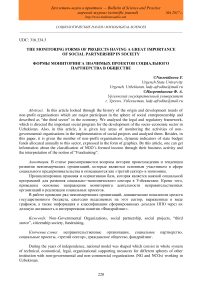The monitoring forms of projects having a great importance of social partnership in society
Автор: Nasretdinova Farangiza
Журнал: Бюллетень науки и практики @bulletennauki
Рубрика: Социологические науки
Статья в выпуске: 4 (17), 2017 года.
Бесплатный доступ
In this article looked through the history of the origin and development trends of non-profit organisations which are major participant in the sphere of social entrepreneurship and described as “the third sector” in the economy. We analysed the legal and regulatory framework, which is directed the important social program for the development of the socio-economic sector in Uzbekistan. Also, in this article, it is given key areas of monitoring the activities of non-governmental organisations in the implementation of social projects and analysed them. Besides, in this paper, it is given the number of non-profit organisations, dynamic indicators of state budget funds allocated annually to this sector, expressed in the form of graphics. By this article, one can get information about the classification of NGO’s formed income through their business activity and the interpretation of the notion of “Fundraising”.
Non-governmental organizations, social partnership, social projects, "third sector", citizenship society, fundraising
Короткий адрес: https://sciup.org/14111551
IDR: 14111551 | УДК: 316.334.3 | DOI: 10.5281/zenodo.546362
Список литературы The monitoring forms of projects having a great importance of social partnership in society
- NGO Governance and Management in China/ed. by Hasmath R., Hsu J. Y. J. Abington; New York: Routledge, 2016. 216 p.
- Vakil A. Confronting the classification problem: Toward a taxonomy of NGOs//World Development. 1997. V. 25. №12. P. 2057-2070 DOI: 10.1016/S0305-750X(97)00098-3
- Davies Th. NGOs: A New History of Transnational Civil Society. New York: Oxford University Press, 2014. 301p.
- Зикриллаева Н. А., Тураев А. Т. Социальное партнерство: формирование средств бюджета ННО и других институтов гражданского общества -важный фактор либерализации экономических отношений и социально-экономического развития//Иқтисод ва молия. 2014. №4. С. 12-19.


